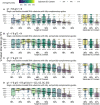Profiling Thermus thermophilus Argonaute Guide DNA Sequence Preferences by Functional Screening
- PMID: 33996915
- PMCID: PMC8118625
- DOI: 10.3389/fmolb.2021.670940
Profiling Thermus thermophilus Argonaute Guide DNA Sequence Preferences by Functional Screening
Abstract
Prokaryotic Argonautes (pAgo) are an increasingly well-studied class of guided endonucleases, and the underlying mechanisms by which pAgo generate nucleic acid guides in vivo remains an important topic of investigation. Recent insights into these mechanisms for the Argonaute protein from Thermus thermophilus has drawn attention to global sequence and structural feature preferences involved in oligonucleotide guide selection. In this work, we approach the study of guide sequence preferences in T. thermophilus Argonaute from a functional perspective. Screening a library of 1,968 guides against randomized single- and double-stranded DNA substrates, endonuclease activity associated with each guide was quantified using high-throughput capillary electrophoresis, and localized sequence preferences were identified which can be used to improve guide design for molecular applications. The most notable preferences include: a strong cleavage enhancement from a first position dT independent of target sequence; a significant decrease in activity with dA at position 12; and an impact of GC dinucleotides at positions 10 and 11. While this method has been useful in characterizing unique preferences of T. thermophilus Argonaute and criteria for creating efficient guides, it could be expanded further to rapidly characterize more recent mesophilic variants reported in the literature and drive their utility toward molecular tools in biology and genome editing applications.
Keywords: Thermus thermophilus; capillary electrophoresis; nucleic acid guide; prokaryotic argonaute; targeted endonuclease.
Copyright © 2021 Hunt, Tamanaha, Bonanno, Cantor and Tanner.
Conflict of interest statement
At the time of this work, the authors were employed by New England Biolabs, Inc., which funded this work and is the manufacturer of reagents used in this manuscript, including Thermus thermophilus Argonaute. Even though the authors were employed and funded by New England Biolabs, Inc., this did not detract from the objectivity of data generation or its interpretation.
Figures






Similar articles
-
High-throughput biochemical profiling reveals functional adaptation of a bacterial Argonaute.Mol Cell. 2022 Apr 7;82(7):1329-1342.e8. doi: 10.1016/j.molcel.2022.02.026. Epub 2022 Mar 16. Mol Cell. 2022. PMID: 35298909 Free PMC article.
-
Single-stranded binding proteins and helicase enhance the activity of prokaryotic argonautes in vitro.PLoS One. 2018 Aug 29;13(8):e0203073. doi: 10.1371/journal.pone.0203073. eCollection 2018. PLoS One. 2018. PMID: 30157272 Free PMC article.
-
An Argonaute from Thermus parvatiensis exhibits endonuclease activity mediated by 5' chemically modified DNA guides.Acta Biochim Biophys Sin (Shanghai). 2022 May 25;54(5):686-695. doi: 10.3724/abbs.2022047. Acta Biochim Biophys Sin (Shanghai). 2022. PMID: 35643958 Free PMC article.
-
Prokaryotic Argonautes for in vivo biotechnology and molecular diagnostics.Trends Biotechnol. 2024 Jan;42(1):61-73. doi: 10.1016/j.tibtech.2023.06.010. Epub 2023 Jul 12. Trends Biotechnol. 2024. PMID: 37451948 Review.
-
Prokaryotic Argonaute proteins: novel genome-editing tools?Nat Rev Microbiol. 2018 Jan;16(1):5-11. doi: 10.1038/nrmicro.2017.73. Epub 2017 Jul 24. Nat Rev Microbiol. 2018. PMID: 28736447 Review.
Cited by
-
Thermus thermophilus Argonaute-based signal amplifier for highly sensitive and specific microRNA detection.Front Bioeng Biotechnol. 2023 Jul 31;11:1221943. doi: 10.3389/fbioe.2023.1221943. eCollection 2023. Front Bioeng Biotechnol. 2023. PMID: 37583711 Free PMC article.
-
Programmable cleavage of linear double-stranded DNA by combined action of Argonaute CbAgo from Clostridium butyricum and nuclease deficient RecBC helicase from E. coli.Nucleic Acids Res. 2022 May 6;50(8):4616-4629. doi: 10.1093/nar/gkac229. Nucleic Acids Res. 2022. PMID: 35420131 Free PMC article.
-
High-throughput biochemical profiling reveals functional adaptation of a bacterial Argonaute.Mol Cell. 2022 Apr 7;82(7):1329-1342.e8. doi: 10.1016/j.molcel.2022.02.026. Epub 2022 Mar 16. Mol Cell. 2022. PMID: 35298909 Free PMC article.
-
In vitro characterization of a pAgo nuclease TtdAgo from Thermococcus thioreducens and evaluation of its effect in vivo.Front Bioeng Biotechnol. 2023 Mar 2;11:1142637. doi: 10.3389/fbioe.2023.1142637. eCollection 2023. Front Bioeng Biotechnol. 2023. PMID: 36937752 Free PMC article.
-
Prokaryotic Argonaute Proteins as a Tool for Biotechnology.Mol Biol. 2022;56(6):854-873. doi: 10.1134/S0026893322060103. Epub 2022 Aug 30. Mol Biol. 2022. PMID: 36060308 Free PMC article.
References
-
- Greenough L., Schermerhorn K. M., Mazzola L., Bybee J., Rivizzigno D., Cantin E., et al. (2016). Adapting capillary gel electrophoresis as a sensitive, high-throughput method to accelerate characterization of nucleic acid metabolic enzymes. Nucleic Acids Res. 44:e15. 10.1093/nar/gkv899 - DOI - PMC - PubMed
LinkOut - more resources
Full Text Sources
Other Literature Sources
Miscellaneous

